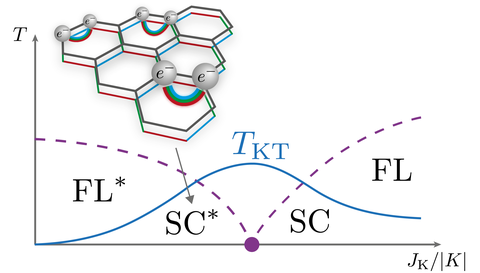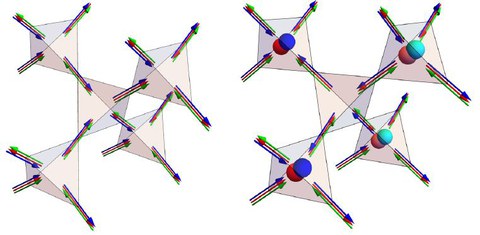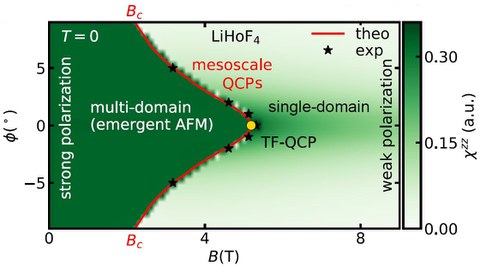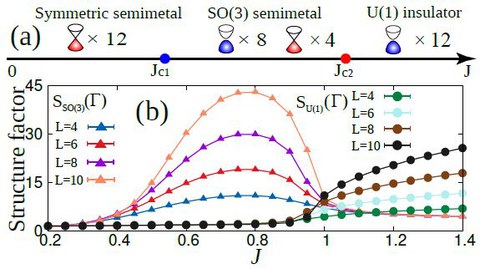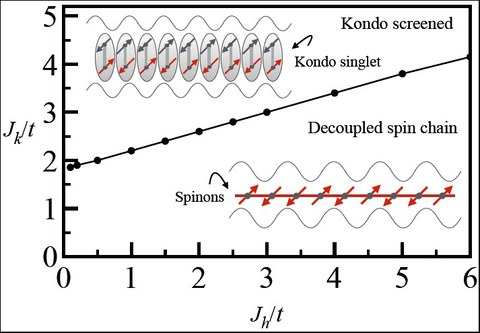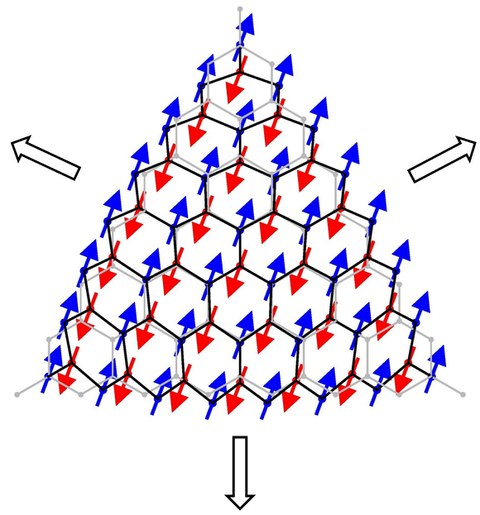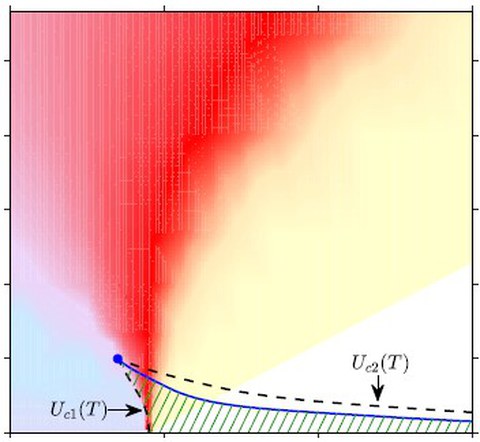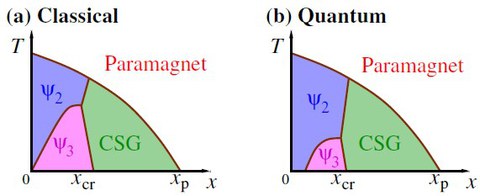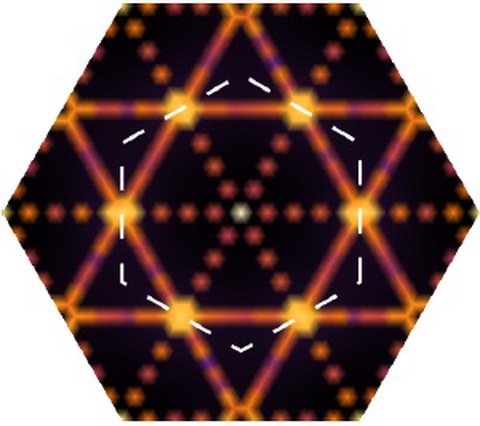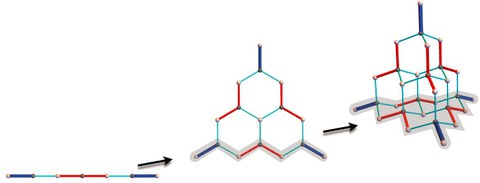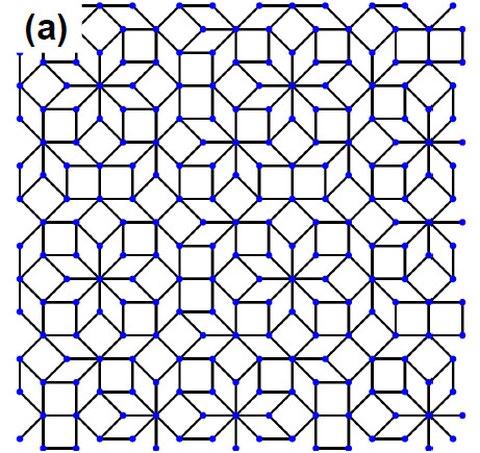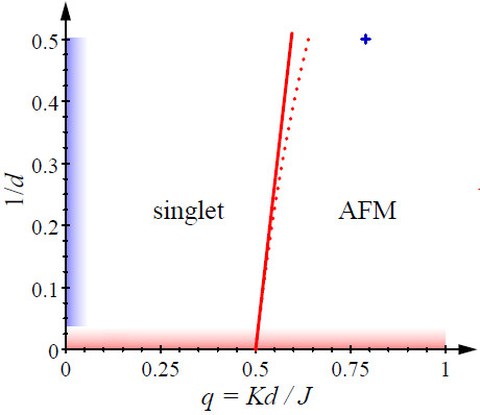Research Fields
- Strongly correlated electrons and novel phases
- Quantum phase transitions
- Frustrated magnets and spin liquids
- Topological phases (insulators, superconductors, magnets)
- High-temperature superconductors
- Heavy-fermion metals
- Cold atoms in optical lattices
- Quantum impurity problems
- Dissipative quantum systems
Recent Highlights
Novel phases near Kondo-breakdown quantum phase transitions
In metals with local moments, the lattice Kondo effect generates a paramagnetic heavy Fermi liquid (FL). In situations with magnetic frustration, the breakdown of this Kondo effect can lead to topological non-Fermi liquids, most prominently the fractionalized Fermi liquid (FL*) where conduction electrons coexist with a spin-liquid background. We have identified novel phases which can emerge near an FL-FL* quantum phase transition: If the FL* phase features a pi-flux U(1) spin liquid, then the onset of Kondo screening leads to a continuous change of the emergent gauge flux, resulting in a time-reversal-symmetry-breaking (i.e. chiral) heavy-fermion state. If the FL* phase features a Z2 spin liquid, then it can display a low-temperature instability towards a fractionalized superconducting state (SC*), where Cooper pairs coexist with a spin-liquid background.
- T. Drechsler and M. Vojta, Phys. Rev. Lett. 134, 106503 (2025) (Phys. Rev. Lett.)(arXiv)
- M. Bunney, U. F. P. Seifert, S. Rachel, and M. Vojta, arXiv:2411.07201 (arXiv)
Classical chiral spin liquid on the pyrochlore lattice
Frustrated magets are the source for many novel forms of order and disorder. We have identified a novel chiral spin liquid for classical spins on the pyrochlore lattice coupled via a chiral three-body interaction. The chiral spin liquid is described by an effective gauge theory and displays fracton-like excitations.
D. Lozano-Gómez, Y. Iqbal, and M. Vojta, Nat. Commun. 15, 10162 (2024) (Nat. Commun.)(arXiv)
Emergence of mesoscale quantum phase transitions in a ferromagnet
LiHoF4 is a textbook example for a material displaying a transverse-field Ising quantum phase transition. We have studied its behavior for applied fields tilted away from the direction transverse to the easy axis and found - surprisingly - a line of sharp phase transitions at low temperatures, in contrast to the crossover expected from microscopic theory. These transition involve the appearance or disappearance of magnetic domains and hence are of mesoscopic character. Our detailed modelling is in excellent agreement with experimental data.
- A. Wendl, H. Eisenlohr, F. Rucker, C. Duvinage, M. Kleinhans, M. Vojta, and C. Pfleiderer, Nature 609, 65 (2022) (Nature)(arXiv)
Exotic quantum phase transitions in Dirac semimetals
Fermion interactions in Dirac semimetals can lead to a variety of ordering phenomena. We have studied different microscopic models which admit (i) phases with electron-nematic order and (ii) phases which break a built-in SO(3)xU(1) symmetry. Using field theory and quantum Monte-Carlo simulations, we were able to fully characterize the resulting quantum phase transition. Among the findings is a novel instance of deconfined quantum criticality.
- J. Schwab, L. Janssen, K. Sun, Z. Y. Meng, I. F. Herbut, M. Vojta, and F. F. Assaad, Phys. Rev. Lett. 128, 157203 (2022) (Phys. Rev. Lett.)(arXiv)
- Z. H. Liu, M. Vojta, F. F. Assaad, and L. Janssen, Phys. Rev. Lett. 128, 087201 (2022) (Phys. Rev. Lett.)(arXiv)
Kondo breakdown in a spin chain on a semimetal
The Kondo effect describes the screening of magnetic moments in metals. Its breakdown can lead to unconventional phase transitions and exotic phases. We have studied the physics of a spin chain coupled to a two-dimensional Dirac semimetal. This system shown a non-trivial quantum phase transition where the Kondo effect breaks down. These results are relevant for instance for magnetic adatoms on graphene.
- B. Danu, M. Vojta, F. F. Assaad, and T. Grover, Phys. Rev. Lett. 125, 206602 (2020) (Phys. Rev. Lett.)(arXiv)
Magnon Landau levels in strained antiferromagnets
Strain has become an important tool to engineer novel states of matter. In particular, inhomogeneous strain applied to lattice systems can induce artificial gauge fields for particles moving on this lattice. We have demonstrated how to engineer a novel state in Mott-insulating magnets, namely an antiferromagnet with a Landau-level excitation spectrum of magnons.
- M. M. Nayga, S. Rachel, and M. Vojta, Phys. Rev. Lett. 123, 207204 (2019) ( Phys. Rev. Lett.), (arXiv)
Local Mott quantum criticality in the Hubbard model
The interaction-driven Mott metal-Insulator transition is one of the most important phenomena of strongly correlated electrons. Searching for quantum criticality in the framework of dynamical mean-field theory for the one-band Hubbard model, we have found a scale-invariant, i.e. critical, isolating state at T=0 whose finite-temperature dynamics controls quantum-critical behavior in both the single-particle spectrum and the electrical resistivity.
- H. Eisenlohr, S.-S. B. Lee, M. Vojta, Phys Rev. B 100, 155152 (2019) (Phys. Rev. B) (arXiv)
Cluster spin-glass phase in disordered pyrochlore magnets
Magnets with pyrochlore lattice structure form one of the most interesting families of geometrically frustrated magnets. In the presence of an XY anisotropy, they realize order states via a fluctuation-driven order-by-disorder mechanism. We have studied the effect of quenched disorder (i.e. lattice defects) and found a novel spin-glass phase, thus explaining existing experiments.
- E. C. Andrade, J. A. Hoyos, S. Rachel, and M. Vojta, Phys. Rev. Lett. 120, 097204 (2018) (Phys. Rev. Lett.)(arXiv)
Heisenberg-Kitaev model in a magnetic field
The Heisenberg-Kitaev model, discussed for materials like Na2IrO3 oder alpha-RuCl3, describes spin systems with so-called compass interactions on the honeycomb lattice. We have systematically studied the effect of an external magnetic field and determined phase diagrams for different field directions. For <111> fields we find a number of non-trivial phases, including multi-Q states and vortex crystals.
- L. Janssen, E. C. Andrade, and M. Vojta, Phys. Rev. Lett. 117, 277202 (2016) (Phys. Rev. Lett.) (arXiv)
Strain-induced Landau Levels in arbitrary dimensions with an exact spectrum
Free electrons in two space dimensions subject to a magnetic field realize Landau levels, highly degenerate states which form the basis of the quantum Hall effect. Artificial approximate Landau levels can be induced by suitable lattice deformations also in the absence of a magnetic field. We have introduced and solved a family of models for strained bipartite lattices which yield perfectly quantized Landau levels in arbitrary space dimensions.
- S. Rachel, I. Göthel, D. P. Arovas, and M. Vojta, Phys. Rev. Lett. 117, 266801 (2016) (Phys. Rev. Lett.) (arXiv)
Kondo effect in quasicrystals
The Kondo effect describes the screening of a magnetic impurity embedded into a metallic host - the latter is typically a crystal with a periodic arrangement of atoms. We have theoretically investigated, for the first time, the Kondo effect in quasicrystalline metal. A quasicrystal is a solid in which atoms are arranged in a non-periodic fashion. Our results show strong spatial fluctuations of screening, leading to a broad distribution of Kondo temperatures which eventually causes non-Fermi liquid behavior.
- E. C. Andrade, A. Jagannathan, E. Miranda, M. Vojta, and V. Dobrosavljevic, Phys. Rev. Lett. 115, 036403 (2015) (Phys. Rev. Lett.) (arXiv)
Systematic expansion for quantum critical magnets
Quantum magnets built from pairs of coupled spins display interesting quantum phase transitions. We have developed a novel non-linear bond-operator theory which enables a analytic description of such systems in a systematic expansion in 1/d where d is the number of spatial dimensions.
- D. G. Joshi and M. Vojta, Phys. Rev. B 91, 094405 (2015) (Phys. Rev. B) (arXiv)
- D. G. Joshi, K. Coester, K. P Schmidt, and M. Vojta, Phys. Rev. B 91, 094404 (2015) (Phys. Rev. B) (arXiv)
